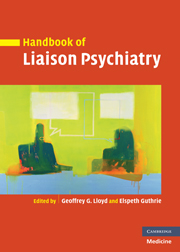Book contents
- Frontmatter
- Contents
- List of contributors
- Preface
- Part I Basic skills
- Part II Common psychiatric problems across the general hospital
- 7 Functional somatic syndromes
- 8 Alcohol problems in the general hospital
- 9 Drug misuse in medical patients
- 10 Sexual problems in medical patients
- 11 Suicide and deliberate self-harm
- 12 Delirium
- 13 Childhood experiences
- Part III Working with specific units
- Part IV Treatment
- Part V Different treatment settings
- Index
- References
8 - Alcohol problems in the general hospital
from Part II - Common psychiatric problems across the general hospital
Published online by Cambridge University Press: 10 December 2009
- Frontmatter
- Contents
- List of contributors
- Preface
- Part I Basic skills
- Part II Common psychiatric problems across the general hospital
- 7 Functional somatic syndromes
- 8 Alcohol problems in the general hospital
- 9 Drug misuse in medical patients
- 10 Sexual problems in medical patients
- 11 Suicide and deliberate self-harm
- 12 Delirium
- 13 Childhood experiences
- Part III Working with specific units
- Part IV Treatment
- Part V Different treatment settings
- Index
- References
Summary
Liaison psychiatrists may have misgivings when surgeons and physicians refer patients with alcohol problems. Psychiatrists have no monopoly in how to advise on lifestyle change. The professional background of those treating the problem drinker differs between cities and countries, and the available services vary greatly. That alcohol problems are seen in all departments of a general hospital is not in doubt, as will be seen in the first section of this chapter. What can then be done effectively, and by whom, follows later.
Alcohol-related diseases
Table 8.1 lists the conditions seen in the general hospital with an established association with alcohol consumption. Epidemiological overviews including meta-analyses have quantified the relationship of alcohol consumption to morbidity and mortality (English et al. 1995; Gutjahr & Gmel 2001; Single et al. 1999). Beyond lists of harm, these epidemiological reviews agree that for some disorders of middle age, namely coronary heart disease, ischaemic stroke, diabetes and cholelithiasis, consumption of alcohol up to four ‘drinks’ per day (40 g ethanol, or five UK ‘units’; three ‘drinks’ per day for women) is associated with reduced morbidity and mortality.
Some non-fatal conditions appear in Table 8.1, e.g. nosebleed (McGarry et al. 1994), myopathy (Preedy & Peters 1994) and, known for centuries, secondary erectile impotence. Some admissions to medical wards that do not acquire a disease appellation have also been shown to be alcohol-related, such as ‘non-specific chest pain’ (Chick et al. 2000) or ‘variant angina’ (e.g. Matsuguchi et al. 1984).
Keywords
- Type
- Chapter
- Information
- Handbook of Liaison Psychiatry , pp. 149 - 179Publisher: Cambridge University PressPrint publication year: 2007

